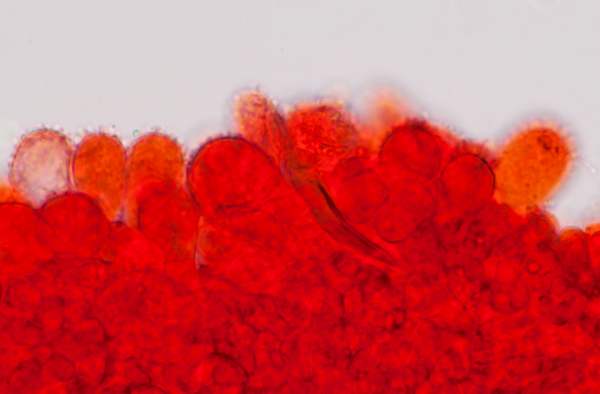Mycena flavescens Velen.
Phylum: Basidiomycota - Class: Agaricomycetes - Order: Agaricales - Family: Mycenaceae
Distribution - Taxonomic History - Etymology - Identification - Culinary Notes - Reference Sources
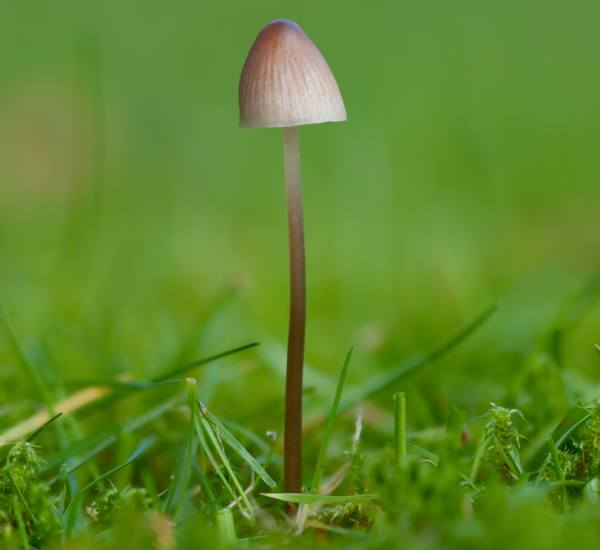
Many of the bonnet fungi are difficult to identify with confidence, and Mycena flavescens is quite a challenging one because there are several other pallid little bonnet mushrooms that grown in the same kinds of habitats. Macroscopic and microscopic characters should therefore be checked when species level identity of small pale bonnet-shaped mushrooms is required.
Distribution
This little mushroom is an occasional find in Britain and Ireland; it is also recorded throughout most of mainland Europe from Scandinavia down to Italy and Spain; however, in many countries its occurrentce in records is infrequent or rare
Taxonomic history
When in 1920 Czech mycologist Josef Velenovsky described this bonnet mushroom, he gave it its currently-accepted scientific name Mycena flavescens
Etymology
The specific epithet flavescens comes from the prefix flavo- meaning yellow and the suffix -escens indicating a gradual change process. This is a reference to the way the gill edges of these bonnet mushrooms sometimes (but certainly not always) turn yellowish.
Identification guide
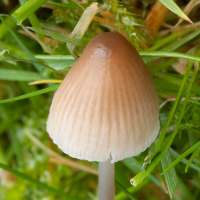 |
Cap0.5 to 1.5cm in diameter when fully mature, the caps are initially conical or campanulate, becoming broadly convex, sometimes with an umbo; translucently striate almost to the cap centre; dark to mid brown central disc fading to almost white at the margin. The thin cap flesh is whitish. |
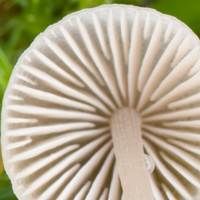 |
GillsAdnate, ventricose, the moderately-spaced gills are white at first, often becoming yellowish, especially towards the edge of the cap. StemCylindrical, hollow, 1.5-7cm long and 0.5-2mm in diameter, the stems are pale brown and very finely pruinose (powdery) towards the apex, darker vinaceous brown (significantly darker than the cap) and smooth below. |
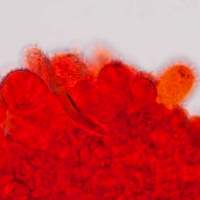 |
CheilocystidiaCheilocystidia (cystidia on the gill edges) 20-40 x 12-20μm, ellipsoidal to broadly clavate, densely covered in short spiky warts or cylindrical excrescenses. Pleurocystidia (cystidia on the gill faces) are similar to the cheilocystodia. |
SporesLacrymoid, smooth, 7.9-10 x 4.5-5.1µm; amyloid. (the basidia are four-spored.) Spore printWhite. |
|
Odour/taste |
Odour (and possibly also taste) earthy or of raw potato. |
Habitat & Ecological role |
Saprobic; scattered or fasciculate; sometimes on mossy lawns more often on grassy woodland edges, among leaf litter in deciduous woodlands, and among needle litter in coniferous forests. |
Season |
August to late November in Britain and Ireland. |
Similar species |
There are numerous bell-shaped fungi in the Mycena genus, several of which are macroscopically quite similar to Mycena flavescens and few of them are easily separated in the field. |
Culinary Notes
Although recorded in some field guides as edible, these little mushrooms are far too insubstantial to be of any serious culinary interest.
Reference Sources
Fascinated by Fungi, 2nd Edition, Pat O'Reilly 2016, reprinted by Coch-y-bonddu Books in 2022.
Penny Cullington, (Oct. 2013). British Mycenas - Brief Descriptions.
Giovanni Robich, (2003). Mycena d'Europa; Associazione Micologica Bresadola ; Vicenza : Fondazione Centro Studi Micologici.
British Mycological Society, English Names for Fungi
Dictionary of the Fungi; Paul M. Kirk, Paul F. Cannon, David W. Minter and J. A. Stalpers; CABI, 2008
Taxonomic history and synonym information on these pages is drawn from many sources but in particular from the British Mycological Society's GB Checklist of Fungi.
Acknowledgements
This page includes pictures kindly contributed by David Kelly.
Fascinated by Fungi. Back by popular demand, Pat O'Reilly's best-selling 450-page hardback book is available now. The latest second edition was republished with a sparkling new cover design in September 2022 by Coch-y-Bonddu Books. Full details and copies are available from the publisher's online bookshop...
